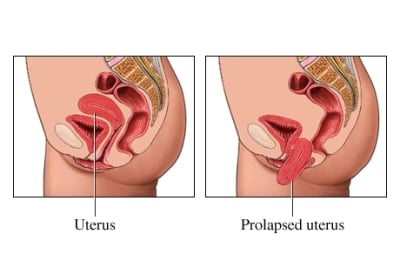
Pelvic organ prolapse occurs when one of your pelvic organs ‘drops’ because it is no longer held in the correct position. There are four stages of prolapse, 1 being the mildest and 4 being the most severe – stage 3 and 4 are also known as procidentia, which means the prolapsed organ protrudes out of the body.
Any pelvic organ can prolapse, and common prolapse conditions include bladder prolapse (cystocele), urethral prolapse, uterine (womb) prolapse, vaginal vault prolapse, bowel prolapse (enterocele) and rectal prolapse (rectocele).
Before resorting to surgery, there are other, more conservative treatment options for prolapse, including pelvic floor exercise (which we of course recommend strongly) and the use of a vaginal pessary. However, if your surgeon decides that surgery is the best option, you will want to know about your prolapse surgery. There are a number of different options available, depending on the type of prolapse.
What are the different types of prolapse surgery?
- Vaginal Repair: prolapse surgery often involves vaginal repair. This may include a vaginal hysterectomy where your uterus is removed via the vagina. This won’t leave a scar as all the stitches are internal. Once this has been done, the surgeon will often use a mesh (TVT) to help support your vagina and prevent further prolapse.
- Posterior Intravaginal Sling Plasty: sometimes women suffer vaginal prolapse after hysterectomy. To treat this, the surgeon will place a mesh inside the vagina to ‘anchor’ it and help to support the vagina.
- Sacrospinous Fixation: to support the vagina, sometimes the surgeons will place one or two very deep internal stitches inside you. The stitch goes into a strong ligament in your pelvis, called the sacrospinous ligament, and this aims to help to prevent your prolapse from coming back.
- Sacrocolpoplexy: if you have a particularly severe or complicated prolapse, surgeons may perform this type of operation. The surgeons will make a cut across your abdomen, to fix the vagina to the bone to the back of your pelvis. This will then be supported by a mesh to give stronger support and help to hold things in place.
What are the risks of prolapse surgery?
As with any surgery, there are risks associated with prolapse surgery.
- TVT mesh erosion: in the news recently, there have been some TVT scares. With prolapse surgery, there is the risk that the mesh used to support your internal organs can erode or become infected. This is a small risk, but may require further surgery to remove the mesh or repair it.
- Further prolapse: it has been shown that about a third of women who undergo prolapse surgery end up having further surgery because there is a strong link between prolapse – if a woman has had one prolapse, it is possible that she may get another. That is why it is so important to strengthen the pelvic floor both before and after surgery.
- Not all symptoms may improve: many women find that although they no longer have the ‘bulging’ or ‘dragging’ associated with prolapse after surgery, they still may suffer with incontinence or constipation because prolapse surgery only treats the symptoms, not the underlying cause of prolapse. Again, it is vitally important to strengthen the pelvic floor, not only to prevent your prolapse from recurring, but to help treat the incontinence symptoms too.
The Kegel8 Ultra 20 Electronic Pelvic Toner features a programme especially for those of us suffering from pelvic organ prolapse. Strengthening your pelvic floor muscles before and after prolapse surgery with a pelvic floor toner will greatly improve your surgical outcome and help you to avoid further prolapse surgery in the future.
After prolapse surgery with or without pelvic floor repair, it’s vitally important to Kegel exercise – this will give you the best possible surgical outcomes. You can do the 'manual' squeeze and lift exercises or you can invest in a pelvic floor toner to automatically strengthen and tone your pelvic floor. It’s important to remember that you should not use electronic stimulation for around 3 months after surgery, until your surgeon gives the all-clear.
Kegel8 are here to help you, so if you need any advice on how a Kegel8 pelvic toner can help with prolapse, please call us – we’re always happy to help.





